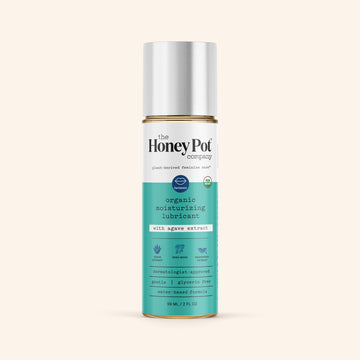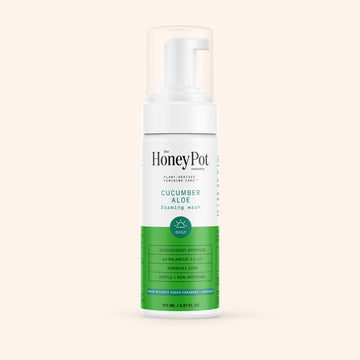As humans with vaginas, we can often identify when something is off “down there”. I know that I can identify when something has disrupted the natural environment of my honeypot. It may be a change of smell or difference in vaginal discharge, but something will alert me that there’s been a flag on the play *blows whistle*!
The environment of a vagina is called the “vaginal microbiome” or "vaginal flora”. The vaginal microbiome is the ecosystem of the vagina, a collection of various microbes. The microbes are usually bacteria – but can consist of invaders such as viruses, unicellular algae, protozoans, and fungi. This may sound scary, but do not fear – usually, our vaginas, or “the host”, have a mutually beneficial relationship between these bacterias. The vagina provides key nutrients needed to support life and growth of the (epithelial) cells and (granular) secretions present in the environment. The bacterial communities protect the host (vagina) from other potentially harmful (pathogenic) organisms including bacterial vaginosis (BV), yeast infections, sexually transmitted infections (STIs), and urinary tract infections (UTIs).
The most common bacteria in the vagina is the Lactobacilli species, which accounts for at least 90-95% of the bacteria present. Lactobacillus has been identified as the “good bacteria'' because of its ability to produce various antimicrobial compounds (hydrogen peroxide and target-specific bacteriocins). Lactobacillus also produces lactic acid, which benefits the vagina by lowering the vaginal pH. In fact, The Honey Pot Co. often includes lactic acid in their vaginal washes to help us maintain a healthy vaginal pH level! A healthy vaginal pH of 3.5-4.5 makes the vaginal environment intolerable and helps inhibit the growth of potential pathogens and anaerobic bacteria, such as: Escherichia coli (E. coli), Gardnerella vaginalis, Candida species, and Atopobium Vaginae. These bacteria are considered “bad bacteria” when located in the vagina. The vaginal microbiome does not like diversity, although over 50 species have been identified in the vagina. Usually "good” bacteria outnumber "bad” bacteria. However, when the “bad” bacteria outnumbers the “good” bacteria, the vaginal flora is in a state of “imbalance” or “dysbiosis”.
Multiple factors can disrupt the vaginal flora and cause imbalance. These agitators include but are not limited to: the use of antibiotics, a compromised immune system of the host, sexual activity, lubricants, douches, hormonal contraceptives, other birth control methods, menstrual cycles, aging, pregnancy, perfumed intimate cleansers, and diets high in sugar and processed foods. Diet and gut health play a large role in the health of our vaginal microbiome. Research has shown that individuals who follow an “ovo-vegetarian diet" characterized by all kinds of vegetables, beans, whole grains, and eggs have decreased odds of developing vaginal dysbiosis. However, individuals who follow an "unhealthy diet” characterized by consuming high sugar, solid oils, sweets, desserts, red meat, fried potato, refined grains, visceral meat, and sweet drinks increase the odds of developing vaginal dysbiosis.
When imbalances occur, the host may experience symptoms such as vaginal itching, burning, abnormal discharge, vaginal odor, irritation, and an increased risk of infection. The most prevalent disorder of the vaginal microbiota among women of reproductive age is bacterial vaginosis (BV). BV is characterized by the decline in the total number of Lactobacillus and an increase in the concentration of anaerobic microbes. Symptoms of BV include: increased vaginal discharge (that may be gray, white or green), “foul-smelling, fishy" vaginal odor, vaginal itching, and burning during urination. Risk factors for developing BV include: having new sexual partners, lack of condom use, vaginal douching, smoking, and menstrual blood. However, many women frequently get BV without these risk factors.
Tips to support a healthy vaginal flora and get back to balance:
1. Adopt healthy hygiene habits
- clean the genital region with mild, cleanser before rinsing well and patting dry daily or as needed during menstruation
- wipe from front to back
2. Wear loose-fitting cotton underwear
3. Use antibiotics only when necessary
4. Maintain a healthy weight
5. Exercise regularly & refresh with The Honey Pot’s foaming wash and wipes
6. Stay hydrated (aim to consume at least half your body weight in ounces) and add electrolytes if necessary
7. Consume a diet that supports a balanced vaginal microbiome, try eating:
- fiber-rich foods (is most important)
- vegetables
- prebiotic-rich foods
- probiotic-rich foods
- fermented foods (in moderation)
- avoid sugar, yeast, alcohol, and caffeine
8. Reduce your stress levels
I also recommend using supplements and vitamins that benefit vaginal health, especially if you are unable to consume foods and nutrients that promote vaginal wellness. For example, individuals who are lactose intolerant may not be able to consume foods rich in Lactobacillus (i.e. yogurt) . Some vitamins and supplements that support healthy pH levels, benefit the vaginal microbiome, and help fight off infections include:
- Vitamin E - contains antioxidant properties that may help protect the vaginal area from damage
- Vitamin D - helps to maintain normal cell function, prevents vaginal infections, prevents vaginal dryness, and improves vaginal pH
- Vitamin C - supports the immune system, contains antioxidant properties that help the body detox and fight infections.
- Fish oil “omega-3 fatty acids” - reduce vaginal dryness and the risk of infections
- Garlic - provides antifungal and antibacterial support
- Cranberries - supports healthy pH levels in the vagina, helps to kill harmful bacteria, and prevents infections
The vaginal microbiome continually influences our gynecologic health and reproductive health – its health is essential to having a healthy, happy honeypot!
References:
Buchta V. Vaginal microbiome. Ceska Gynekol. 2018 Winter;83(5):371-379. English. PMID: 30848142.
Chen, X., Lu, Y., Chen, T., & Li, R. (2021, April 7). The Female Vaginal Microbiome in Health and Bacterial Vaginosis. https://www.frontiersin.org/articles/10.3389/fcimb.2021.631972
Ma B, Forney LJ, Ravel J. Vaginal microbiome: rethinking health and disease. Annu Rev Microbiol. 2012;66:371-89. doi: 10.1146/annurev-micro-092611-150157. Epub 2012 Jun 28. PMID: 22746335; PMCID: PMC3780402.
Noormohammadi M, Eslamian G, Kazemi SN, Rashidkhani B. Association between dietary patterns and bacterial vaginosis: a case-control study. Sci Rep. 2022 Jul 16;12(1):12199. doi: 10.1038/s41598-022-16505-8. PMID: 35842517; PMCID: PMC9288476.






